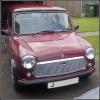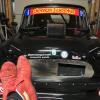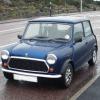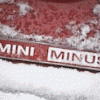Water Heated Inlet Manifold
#1

Posted 13 November 2016 - 09:20 AM
please can I have some advise as to how to plumb in a water heated inlet manifold on a 93 carb mayfair the head outlet is blanked off in the casting and the heater uses the floating? type water valve
Thanks in advance
#2

Posted 13 November 2016 - 10:54 AM
#3

Posted 13 November 2016 - 11:34 AM
That is the point of the water heated type over the exhaust heated ones. With the throttle wide open the air will whiz through too fast to pick up much heat, but it'll still help a lot to stop the fuel condensing out of it warming up and at part throttle.
The factory option was to plumb the manifold in a separate loop between the head outlet and bottom hose, using a flow restrictor. I don't think you'd see much difference plumbing it in series with the heater, preferably manifold first as it'll take less heat out. The added benefit is you can turn off the manifold heating, along with the heater, when the weather's hot.
#4

Posted 13 November 2016 - 11:48 AM
Don't bother. It's only really relevant on Competition engines where condensation can form around the carb body under heavy use and produce ice. That then can cause the engine to stall due to fuel/air problems.
#5

Posted 13 November 2016 - 01:07 PM
It'd be more relevant on a road car with part throttle dropping the induction pressure, and thus temperature. Agreed it's not essential, but consider all the effort car manufacturers go to provide induction system warming.
#6

Posted 13 November 2016 - 02:38 PM
It is purely an economy device. It has nothing to do with condensation or icing on the carb.
The carb is thermally insulated from the manifold. That is why the spacers are made out of a plastic. So any heat that is put into the system is only going into the manifold.
The original cast iron manifolds were joined and do had their own hot spot. This does help with the fuel atomisation and the cast iron set up has been shown to be better than the water heated one for the first few minutes of running but the water heated is better from then on it can also help smooth out the tick over at idle.
But it has an effect on raw power output.
Connect or not is up to you but note that if you have a heater unit that you control the water flow for temperature control rather than one that uses air flow your heated manifold is unlikely to be doing much as the flow will be off.
The Metro had a metal pipe that ran across the back of the block to return the coolant back to the hoses which if it can be found keeps things tidy.
#7

Posted 13 November 2016 - 04:06 PM
God there is some crap in this thread.
It is purely an economy device. It has nothing to do with condensation or icing on the carb.
The carb is thermally insulated from the manifold. That is why the spacers are made out of a plastic. So any heat that is put into the system is only going into the manifold.
The original cast iron manifolds were joined and do had their own hot spot. This does help with the fuel atomisation and the cast iron set up has been shown to be better than the water heated one for the first few minutes of running but the water heated is better from then on it can also help smooth out the tick over at idle.
But it has an effect on raw power output.
Connect or not is up to you but note that if you have a heater unit that you control the water flow for temperature control rather than one that uses air flow your heated manifold is unlikely to be doing much as the flow will be off.
The Metro had a metal pipe that ran across the back of the block to return the coolant back to the hoses which if it can be found keeps things tidy.
Thanks for that. Both my twin HS4 setup and my Weber 28/36 DCD setup used to ice up until I connected the heater pipes to the manifold. That was a 997 Cooper with a 544. If you Google Icing of carburetter then there's loads of info available.
Edited by whistler, 13 November 2016 - 07:04 PM.
#8

Posted 14 November 2016 - 10:26 AM
Thank you very much for all the advice.Now for the next question the car is fitted with the water heated inlet manifold HIF38 KN air filter good quality LCB and single box system.The cat will be removed please can anyone suggest a needle? ABL etc ?
Thanks
#9

Posted 14 November 2016 - 09:56 PM
My car is also a '93 on a hif 38 with very similar mods. Alloy inlet (although i dont have the water plumbed in), K&N element in standard filter housing, maniflow freeflow exhaust manifold going into a single box RC40 set up (removed cat).
I am using an AAM needle currently which has been good. Seems to be running fine, although i havent been able to get to a rolling road yet.
#10

Posted 15 November 2016 - 12:12 AM
God there is some crap in this thread.
It is purely an economy device. It has nothing to do with condensation or icing on the carb.
The carb is thermally insulated from the manifold. That is why the spacers are made out of a plastic. So any heat that is put into the system is only going into the manifold.
There are some spacers made out of aluminium and some are made out of Bakelite, I think there is enough heat in the area to warm up the carb/s unless you reduce it by means of exhaust heat shielding, but that's another controversial topic in itself.
If you don't use it to connect up to your cooling system then you could use it as another guy did on this forum and connected up the crankcase breather pipes (timing cover and clutch housing breather pipes) to each end, tapped a hole in the centre and connected it to the breather pipe on his carb, looked like a neat job.
Edited by neal, 15 November 2016 - 12:24 AM.
#11

Posted 15 November 2016 - 01:01 AM
#12

Posted 15 November 2016 - 01:11 AM
Thanks for that. Both my twin HS4 setup and my Weber 28/36 DCD setup used to ice up until I connected the heater pipes to the manifold. That was a 997 Cooper with a 544. If you Google Icing of carburetter then there's loads of info available.God there is some crap in this thread.
It is purely an economy device. It has nothing to do with condensation or icing on the carb.
The carb is thermally insulated from the manifold. That is why the spacers are made out of a plastic. So any heat that is put into the system is only going into the manifold.
The original cast iron manifolds were joined and do had their own hot spot. This does help with the fuel atomisation and the cast iron set up has been shown to be better than the water heated one for the first few minutes of running but the water heated is better from then on it can also help smooth out the tick over at idle.
But it has an effect on raw power output.
Connect or not is up to you but note that if you have a heater unit that you control the water flow for temperature control rather than one that uses air flow your heated manifold is unlikely to be doing much as the flow will be off.
The Metro had a metal pipe that ran across the back of the block to return the coolant back to the hoses which if it can be found keeps things tidy.
Never sees any twin carb inlet with water heated set up.
Never had issues with my twin 1 1/2s or my DCD on my 1380 with 286. Did have the carb freeze up on the pick up one winter. Put me in a ditch. Playing in the snow in th Pennines is fun.
#13

Posted 15 November 2016 - 01:14 AM
There are some spacers made out of aluminium
These are the early ones as far as I am aware.
#14

Posted 15 November 2016 - 04:55 AM
#15

Posted 15 November 2016 - 02:59 PM
I noticed mine has an aluminium spacer (HIF44), though it looks like it's been hand ground, so not sure if it's a proper spacer or what.
Is the spacer necessary, or is it just to isolate the carb from heat? I ask as mine is on a Minus and that extra spacer means the bonnet sits a few mm higher than it would without it.
Presumably it wants to either be plastic, or not bother?
1 user(s) are reading this topic
0 members, 1 guests, 0 anonymous users




















